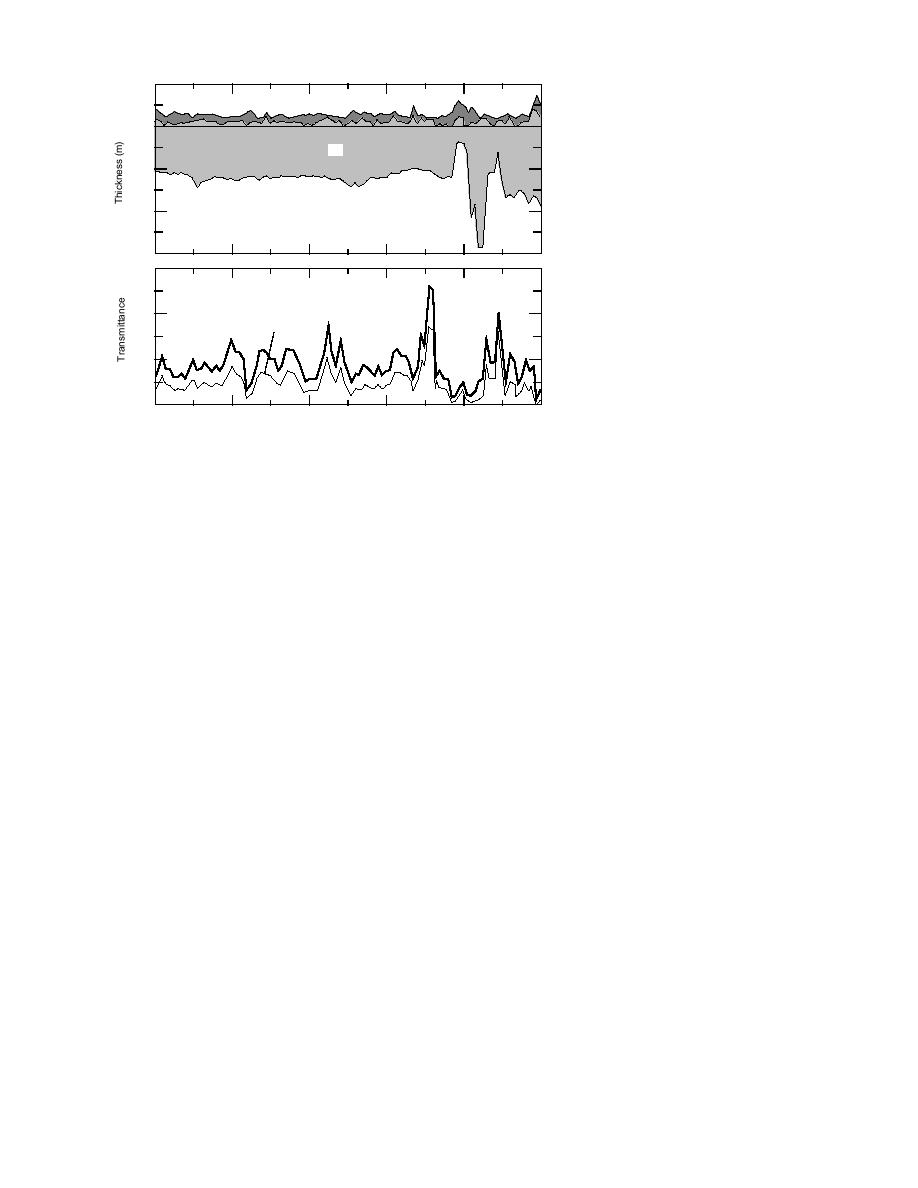
0.4
A
Snow
0
Ice
0.4
Water
0.8
1.2
0.15
B
Figure 17. Theoretical estimates of ultra-
Integrated
violet and visible light transmission
Visible
0.10
Integrated
UV-B
through sea ice in the Weddell Sea. Ice
thickness, snow depth and physical prop-
0.05
erties data are from Lange and Eicken
(1991). Transmitted UV-B and visible
irradiance were computed using a two-
0
20
40
60
80
100
stream model (Perovich 1990, 1993)
Position (m)
cal properties data from Lange and Eicken (1991)
the roots of the Legendre polynomial. In this for-
were used to define the type and thickness of the
mulation, it is no longer necessary to assume that
ice and snow cover (Fig. 17a) along a 100-m
the radiance field is diffuse and that the phase
transect in the Weddell Sea. Ice thicknesses in this
function is isotropic. However, these models, par-
area varied from 0.2 to 1.2 m, while the snow
ticularly for larger numbers of streams, are sig-
depth ranged from 0.0 to 0.2 m. With these input
nificantly more complex computationally.
parameters, the model calculated estimates of
Perovich and Grenfell (1982) developed a two-
transmittance for the biologically harmful UV-B
layer, four-stream model (radiances at two up-
irradiance (280 to 320 nm) and the beneficial pho-
ward and two downward angles) and applied it
tosynthetically active radiation (400 to 700 nm)
to investigate the effects of ice thickness, and the
(Fig. 17b). There is tremendous spatial variability
influence of direct vs. diffuse incident solar ra-
in the UV-B transmittance over the 100-m transect,
diation, on spectral albedo and transmittance.
with values ranging over nearly two orders of
Using experimentally determined phase functions
they found that single scattering albedos (ϖ0) for
magnitude from 0.0015 to 0.09. The primary in-
fluence on transmittance is the snow depth, fol-
young ice were high: from 0.95 for warm melting
lowed by the ice thickness. Maximum transmit-
young ice to 0.9997 for young ice below the eu-
tances are associated with minimum snow depths.
tectic point.
It is evident that the presence of an ice cover
Grenfell (1983, 1991) developed a single-layer,
causes a marked reduction in transmitted light
16-stream model and a multilayer, four-stream
levels. This reduction is greater for the harmful
model to explore relationships between ice physi-
UV-B than for the beneficial visible, implying that
cal properties and ice optical properties. The four-
sea ice may moderate the biological impact of
stream (Grenfell 1991) model significantly ex-
enhanced incident ultraviolet irradiance on biota
tended the work of Perovich and Grenfell (1982)
living in and under the ice.
by including vertically varying ice properties. The
Models based on the discrete ordinates method
single-layer, 16-stream model (Grenfell 1983) gen-
(DOM) of Chandrasekhar (1960) have been used
erated a more detailed angular description of ra-
to treat scattering in more detail and examine the
diance, better represented the phase function, and
angular distribution of radiance. In the DOM, the
improved the treatment of refraction at the air-ice
phase function is approximated by a series of
interface for a homogeneous ice cover. This model
Legendre polynomials (Liou 1973, 1974, Mobley
was used to directly link the physical properties
of the ice, such as the inclusion size distributions
1994). The discrete ordinates refer to particular
angles at which the radiance is computed. These
of air bubbles and brine pockets, to radiative trans-
angles are not arbitrary, but are determined from
fer in the ice. The absorption and scattering coef-
17



 Previous Page
Previous Page
